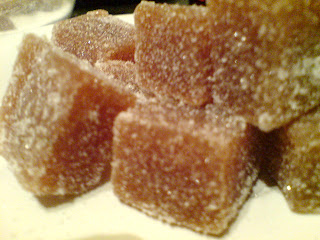#430 Granny Milton's Pears in Brandy
There are only twenty recipes to go until I have cooked the
entirety of English Food by Jane
Grigson, and that means that I am able to give little overviews each time I
finish a section.
The Preserves part
of the book is at the very end, and is probably the part that most modern cooks
would skip or ignore; it’s not as exciting as the meat and fish chapters for
example, and you can buy very good preserves in shops and farmers’ markets
these days. However, I would say, for me, it is one of the most important
sections.
The principle reason for its importance is that it
introduced me to a whole host of British food plants that I had never heard of
(or never thought of eating) such as Cornel cherries, medlars, sorbs,
rowanberries, quinces and Seville oranges.
Also, it equipped me with a huge range of skills, because foods were not just being preserved as jams and jellies, but mediaeval comfits, sugars, flavoured spirits, chutneys, candied peel, orangeades and whole fruits. This, in turn, provided me with a backbone to my food business when it first started back in August 2012; I could line up several preserves on my little market stall and if the day was a washout, they would keep for next time.
#109 Quince Comfits
Also, it equipped me with a huge range of skills, because foods were not just being preserved as jams and jellies, but mediaeval comfits, sugars, flavoured spirits, chutneys, candied peel, orangeades and whole fruits. This, in turn, provided me with a backbone to my food business when it first started back in August 2012; I could line up several preserves on my little market stall and if the day was a washout, they would keep for next time.
#294 Preserved Spiced Oranges
Jane’s recipes always fill me with inspiration, and they continue to do so, but her influence here is greatest, because it has given me the most pleasure, which is also the simplest: the pleasure of cooking the recipes themselves.
Some of the recipes are now standards for me. Her (#24) Seville Orange Marmalade is the simplest
and best recipe I have used, and her #383 Spiced
Redcurrant Jelly too has never been bettered. #397 Herb Jelly is served at almost every roast dinner and is sublime
when made with mint and served up with pie and peas.
#315 Cranberry Jelly
Real surprises in this section was the delicious #46 Rich Orangeade, laced with orange flower water has appeared in several of my pop-up restaurants as it makes such good cocktails! I would also urge you to try #385 Apricot and Pineapple Jam, a preserved made from preserves – dried apricots and tinned pineapples. I really didn’t see the point, but the result was delicious!
If you have never made preserves, the recipes in English Food are an excellent place to
start.
#354 Passion Fruit Curd
That said, there are some real glaring omissions. There is little by the way of chutneys – there are no pickled onions and how could she leave out glorious piccalilli!? Also, there are no, what I would call, proper jams. Where is the strawberry, apricot, blackcurrant, greengage or raspberry jam? I really have no idea why fresh fruit jams wouldn’t make an appearance at all. I am attempting to fill in recipes that have been missed out on the other blog, so have a look there for more preserves recipes. If you spot something missing, please let me know.
#24 Seville Orange Marmalade
All twenty-one recipes from this section are listed below with a hyperlink to each post and the score I awarded them. It scored a mean mark of 7.5 (or if you’d prefer, a median and mode of 8), making it the third best completed part so far. It scored well most of the time but there was no recipe that achieved a top score of ten out of ten.
#127 Banana Chutney 5.5/10
#383 Spiced Redcurrant Jelly 8.5/10
#422 Peppered Redcurrant Jelly 8/10
#114 Quince, Medlar, Sorb or Crab Apple Jelly
6.5/10
#397 Herb Jellies 8/10
#367 Hot Red Pepper Jelly 8.5/10
#385 Apricot and Pineapple Jam 8/10
#255 Lemon Curd 8.5/10
#354 Passion Fruit Curd 6.5/10
#24 Two Whole Orange Marmalades 9/10
#109 Quince Comfits 7/10
#102 Hard Sauce or Brandy Butter 6.5/10
#211 Cumberland Rum Butter 7/10
#430 Granny Milton’s Pears in Brandy
5.5/10
#46 Rich Orangeade (and Lemonade)
8.25/10
#36 Vanilla Sugar 7/10
#266 Concentrated Vanilla Sugar 8/10
#286 Candied Peel 8/10












